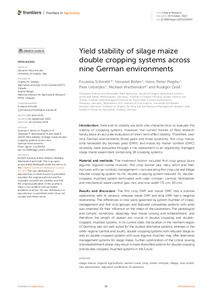| dcterms.abstract | Introduction: Yield and its stability are both vital characteristics to evaluate the viability of cropping systems. However, the current frames of field research hardly allow an accurate evaluation of short-term effect stability. Therefore, over nine German environments (three years and three locations), first crop, maize, total harvested dry biomass yield (DMY), and maize dry matter content (DMC) variability were evaluated through a risk assessment in an organically managed silage maize experiment comprising 18 cropping systems.
Material and methods: The treatment factors included first crop group (pure legume, legume–cereal mixture), first crop (winter pea, hairy vetch and their mixtures with rye, control), management—incorporating first crop use and tillage (double cropping system no-till, double cropping system reduced till, double-cropped, mulched system terminated with roller-crimper, control), fertilization and mechanical weed control (yes–no), and row width (75 cm, 50 cm).
Results and discussion: The first crop DMY and maize DMC had a positive relationship with its variance, whereas maize DMY and total DMY had a negative relationship. The differences in risks were governed by system (number of crops), management and first crop (group), and followed compatible patterns with what was observed for their influence on the mean of the parameters. The pedological and climatic conditions, especially near maize sowing and establishment, and therefore the length of season are crucial in double cropping and double-cropped, mulched systems. In its current state, the location in the northern region of Germany was not well suited for the studied alternative systems, whereas in the other regions (central and south), double cropping systems with reduced tillage as well as double-cropped systems with pure legume mulches may offer alternative management systems for silage maize. Further optimization of the critical sowing and establishment phase may result in more diversified options for double cropping and double-cropped, mulched systems in the future. | eng |


